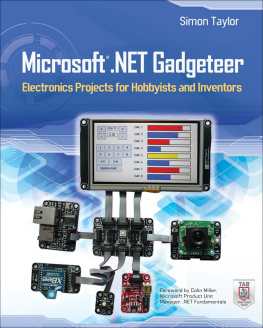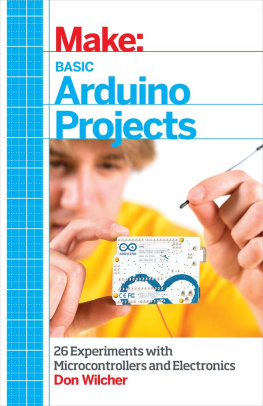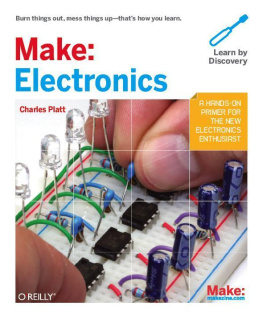Basic Electronics for Tomorrows Inventors
About the Author
Nick Dossis lives in England and holds various qualifications in electronic engineering. He has been playing around with electronics for most of his life, originally encouraged by his grandfather, who bought him his first crystal radio set when he was about seven years old. Nick has also written Brilliant LED Projects: 20 Electronic Designs for Artists, Hobbyists, and Experimenters, another electronics book published by McGraw-Hill Professional (2011). He continues to design and build electronic circuits in his spare time.
Basic Electronics for Tomorrows Inventors
A Thames & Kosmos Book
Nick Dossis
New York Chicago San Francisco
Lisbon London Madrid Mexico City
Milan New Delhi San Juan
Seoul Singapore Sydney Toronto
Copyright 2013 by The McGraw-Hill Companies. All rights reserved. Except as permitted under the United States Copyright Act of 1976, no part of this publication may be reproduced or distributed in any form or by any means, or stored in a database or retrieval system, without the prior written permission of the publisher.
ISBN: 978-0-07-179470-1
MHID: 0-07-179470-0
The material in this eBook also appears in the print version of this title: ISBN: 978-0-07-179469-5,
MHID: 0-07-179469-7.
Thames & Kosmos is a registered trademark of Thames & Kosmos, LLC.
McGraw-Hill eBooks are available at special quantity discounts to use as premiums and sales promotions, or for use in corporate training programs. To contact a representative please e-mail us at .
All trademarks are trademarks of their respective owners. Rather than put a trademark symbol after every occurrence of a trademarked name, we use names in an editorial fashion only, and to the benefit of the trademark owner, with no intention of infringement of the trademark. Where such designations appear in this book, they have been printed with initial caps.
Information has been obtained by McGraw-Hill from sources believed to be reliable. However, because of the possibility of human or mechanical error by our sources, McGraw-Hill, or others, McGraw-Hill does not guarantee the accuracy, adequacy, or completeness of any information and is not responsible for any errors or omissions or the results obtained from the use of such information.
TERMS OF USE
This is a copyrighted work and The McGraw-Hill Companies, Inc. (McGrawHill) and its licensors reserve all rights in and to the work. Use of this work is subject to these terms. Except as permitted under the Copyright Act of 1976 and the right to store and retrieve one copy of the work, you may not decompile, disassemble, reverse engineer, reproduce, modify, create derivative works based upon, transmit, distribute, disseminate, sell, publish or sublicense the work or any part of it without McGraw-Hills prior consent. You may use the work for your own noncommercial and personal use; any other use of the work is strictly prohibited. Your right to use the work may be terminated if you fail to comply with these terms.
THE WORK IS PROVIDED AS IS. McGRAW-HILL AND ITS LICENSORS MAKE NO GUARANTEES OR WARRANTIES AS TO THE ACCURACY, ADEQUACY OR COMPLETENESS OF OR RESULTS TO BE OBTAINED FROM USING THE WORK, INCLUDING ANY INFORMATION THAT CAN BE ACCESSED THROUGH THE WORK VIA HYPERLINK OR OTHERWISE, AND EXPRESSLY DISCLAIM ANY WARRANTY, EXPRESS OR IMPLIED, INCLUDING BUT NOT LIMITED TO IMPLIED WARRANTIES OF MERCHANTABILITY OR FITNESS FOR A PARTICULAR PURPOSE. McGraw-Hill and its licensors do not warrant or guarantee that the functions contained in the work will meet your requirements or that its operation will be uninterrupted or error free. Neither McGraw-Hill nor its licensors shall be liable to you or anyone else for any inaccuracy, error or omission, regardless of cause, in the work or for any damages resulting therefrom. McGraw-Hill has no responsibility for the content of any information accessed through the work. Under no circumstances shall McGraw-Hill and/or its licensors be liable for any indirect, incidental, special, punitive, consequential or similar damages that result from the use of or inability to use the work, even if any of them has been advised of the possibility of such damages. This limitation of liability shall apply to any claim or cause whatsoever whether such claim or cause arises in contract, tort or otherwise.
This is for Elissa, my soul mate. I couldnt have done this without you.
Contents
Acknowledgments
Special thanks go to my family for supporting me as I wrote this book, especially Jasmine and Georgia Dossis, who helped me take a lot of the close-up photography, and who also doubled up as models in some of the photographs. Id also like to thank Roger Stewart of McGraw-Hill Professional for giving me the opportunity to write this book and fulfill another one of my dreams.
Introduction
If you are reading this book, you might be a newcomer to electronics who wants to understand the basics so that you can create some interesting circuits. Or you may have already dabbled in the art of electronics and you want to learn some more. Either way, this book will be useful to anyone who is interested in learning about electronics, and it also aims to be a useful resource for electronic hobbyists of all ages and ability levels. Younger readers might find it useful to have an adult around to help them to get started; however, the circuit diagrams and detailed close-up photographs contained in each chapter make it really easy to follow and build the experiments.
The projects and experiments contained in each chapter use inexpensive, readily available electronic components that you can buy from local electronics stores and many electronic suppliers on the Internet. Also, you dont need to be an expert at soldering to build these experiments, because no soldering is required! All the projects and experiments use breadboard, which creates a plug-and-play environment for you to build your electronic circuits.
Whats Inside the Book?
The book is split into five parts, and I recommend you read the first part, Lets Get Started, before you build any of the experiments, because it explains some important concepts that youll need in order to work through the book. You might also find this part useful as a reference as you read through the book. It introduces the common equipment that you will need, along with the basics about electronic building blocks and the components that you will come across in each experimental part of the book.
The next four parts of the book are packed with experiments and real-world examples that help you understand how some of these devices work. In each part of the book, you will identify some of the electronic building blocks that go into each everyday device discussed.
What Does Each Chapter Contain?
Each experimental chapter starts by providing an introduction to the experiment and then includes the following sections:
The Circuit Diagram The circuit diagram shows how each of the electronic components are connected together to produce the device in each experiment.
How the Circuit Works This section describes the circuit diagram and explains how each part of the circuit works. This section is important to read, because it identifies the building blocks used to make the circuit and also helps you to learn how to read circuit diagrams, which are necessary for creating any type of circuitry.













